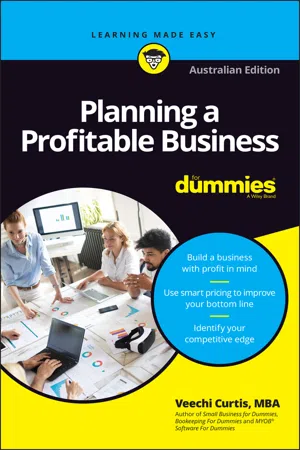
- English
- ePUB (mobile friendly)
- Available on iOS & Android
Planning a Profitable Business For Dummies
About This Book
You don't need to be a'numbers person'tomake your businessprofitable! With Planning a Profitable BusinessFor Dummies, discover the secrets offinancial successand how to generateabove-averageprofits.
Written especially for the Australian audience, Planning a Profitable BusinessForDummies explainshow to build a business with profit in mind, using smart pricing techniquesand clear-eyed strategic planning. Whether you're just getting started in business orstillrecovering from lockdown losses, this bookpoints to where extra profits might lie.
Flip through these pages to learnthe importance of competitive positioning, smart pricing, and how best tosecure an enduringadvantageover your competitors.Reflect on how youcantransition to becomingan entrepreneur, rather than just a business owner, andwhy this distinction is so important.
- Make a safe-and-sound transition into working for yourself byusingproven businessstrategies
- Discoverthe fundamentals of financial projections, margins, and ratios—even if you aren't amathwhiz
- Securefinance for your business andmanageyour working capital wisely
- Identifysavvyexpense-saving ideas, and, when the time is right, sellyour business forthe highest price
Business owners need straightforward, practicaltipsthat ensure that extra edge of profitability.Findthese tipsinside Planning a Profitable Business For Dummies, andpaveyour pathto financial success.
Frequently asked questions
Information
Building a Business with Profit in Mind





Shifting to an Entrepreneur Mindset
- My local plumbing company has a team of plumbers, each with their own van and apprentice. The owner occasionally helps with tricky jobs, but mostly focuses on management and marketing.
- The place where my son used to learn piano is a music school, with lots of different tutors teaching different instruments. The owners teach sometimes, but rely on a team of teachers to deliver most of the lessons.
- A girlfriend of mine has a business selling baby sleeping bags. She no longer stitches each sleeping bag herself. Instead, she still manages the design, marketing and distribution, but has shifted production offshore.
- My neighbour runs a small chain of three cafes. He rarely cooks or serves tables any more, but focuses on the finances and management.
Finding the Secret to Profit
- The first type of business is one that has been done before, and therefore has been tried and tested. I call this a traditional business.
- The second type of business is one that finds its own niche, thereby doing something especially tailored to a small group of customers. I call this a niche business.
- The third type of business is one that launches an entirely new concept on the world. I call this an entrepreneur business.
Expressing your difference in a traditional business
- A regional bookshop acts not just as a retail store, but doubles as a quasi-community centre, with morning teas, book clubs and regular author readings.
- A guitar teacher livestreams a performance of his original music each month, selling charts for these compositions, promoting his online lessons and attracting regular donations via Patreon.
- A vet provides a 24-hour mobile service to people’s homes.
- A cabinet maker mills his own wood on his 30-acre property on the South Coast of NSW, using this timber for his custom-built high-end furniture.
- In addition to regular services, a mechanic offers monthly do-it-yourself classes where she teaches customers how to do basic maintenance on their own vehicles.
Marketing to a niche
Table of contents
- Cover
- Title Page
- Table of Contents
- Introduction
- Chapter 1: Building a Business with Profit in Mind
- Chapter 2: Finding Your Competitive Edge
- Chapter 3: Staying One Step Ahead
- Chapter 4: Guarding Your Working Capital
- Chapter 5: Pricing for Profits
- Chapter 6: Setting Sales Targets With Profit in Mind
- Chapter 7: Modelling Business Scenarios
- Chapter 8: Making Magic with Margins
- Chapter 9: Using Reports to Boost Your Profits
- Chapter 10: Ten (Almost!) Tips for Improving Your Bottom Line
- Chapter 11: Ten Tips for Selling Your Business
- Index
- About the Author
- Connect with Dummies
- End User License Agreement

